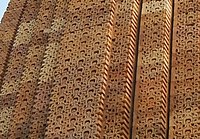Gavaksha

In
Like the whole of the classic chaitya, the form originated in the shape of the wooden thatched roofs of buildings, none of which have survived; the earliest version replicating such roofs in stone is at the entrance to the non-Buddhist Lomas Rishi Cave, one of the man-made Barabar Caves in Bihar.[5]
The "chaitya arch" around the large window above the entrance frequently appears repeated as a small motif in decoration, and evolved versions continue into Hindu decoration, long after actual chaityas had ceased to be built.[6] In these cases it can become an elaborate cartouche-like frame, spreading rather wide, around a circular or semi-circular medallion, which may contain a sculpture of a figure or head. An early stage is shown in the entrance to Cave 9 at the Ajanta Caves, where the chaitya arch window frame is repeated several times as a decorative motif. Here, and in many similar early examples, the interior of the arch in the motif contains low relief lattice imitating receding roof timbers (purlins).
First stage
The arched gable-end form seen at the Lomas Rishi Cave and other sites appears as a feature of both sacred and secular buildings represented in reliefs from early Buddhist sites in India, and was evidently widely used for roofs made from plant materials in ancient Indian architecture.[7] Simple versions of similar structures remain in use today by the
The rock-cut Lomas Rishi Cave was excavated during the reign of

Early rock-cut
At the entrance to Cave 19 at Ajanta, four horizontal zones of the decoration use repeated "chaitya arch" motifs on an otherwise plain band (two on the projecting porch, and two above). There is a head inside each arch. Early examples include Ellora Caves 10, Ajanta Caves 9 and 19 and Varaha Cave Temple at Mamallapuram.[12]
-
Interior of a rock-cut chaitya hall, Bhaja Caves, the ribs in wood
-
Chaitya arch motif in avihara at Bedse Caves
-
Side wall inside the chaitya at Bedse Caves
-
Development of the Chaitya Arch from Lomas Rishi Cave, from a book by Percy Brown.
-
Scene on the Bodh Gaya railings (replica), representing a building
-
Exterior of chaitya hall, Cave 9, Ajanta Caves, 1st century BCE. The chaitya arch window frame is repeated several times as a decorative motif.
-
Chaitya arch motif in aviharaat Ajanta
-
Entrance to Cave 19, Ajanta Caves, late 5th century, also with four zones using the "chaitya arch" motif
-
Modern hut of the Toda people
Later development
By around 650, the time of the last rock-cut chaitya hall, Cave 10 at
Also in the 7th century, the sukanasa developed. This is a very large developed gavaksha motif fixed on the outside of the temple tower over its entrance, normally standing vertical, although the tower slopes inwards.[14]
By the end of the 7th century, and perhaps earlier, the entire faces of large
Gop Temple in Gujarat, probably from the 6th century, is the largest and finest of a group of early temples in a distinct local style. The bare castle-like appearance of the central square tower today probably does not reflect the original design, as the upper parts of the structure around it are missing. Above the plain walls the sloping top includes three large gavakshas on each face, two below and one above, which are unusual in actually being open, rather than in shallow relief, like almost all later gavakshas. Originally statues stood behind them, of which very little now remains.[18]
Gavakshas are prominent in some temples of the 8th century group on the Dieng plateau in central Java, among the earliest monumental Hindu temples in modern Indonesia.[19]
Nāsīs of the south
-
North roof of Gop Surya temple, Gujarat, c. late 6th / early 7th century
-
Two chaitya arch motifs on top of each other. Hindu temple, Osian, Jodhpur, 8th century.
-
Gavaksha atNalanda
-
Shiva Nataraja and small gavaksha motifs, Jambulingeshwara Temple, Pattadakal, 7th-8th century.[21]
-
The decoration of the 9th-century Kasivisvanatha temple at Pattadakal includes gavakshas in several forms
-
Elaborated gavakshas at the early 9th-century Jain Cave 32 atEllora
-
"Honeycomb" of gavakshas on the shikhara of the Vamana Temple, Khajuraho, 1050-75
-
Candi Bima temple, Dieng temples, Java, 8th century
-
Mahabalipuram
Notes
- ^ properly: candraśālās, gavākṣa, kūḍu. Harle, 49, 166, 276. Harle restricts use of candraśālā to examples from the Gupta period, when contemporary texts use that term.
- ^ "Glossary of Indian Art". Retrieved 2015-05-18.
- ^ Harle, 48
- ^ Elgood (2000), 103
- ^ Harle, 48; Michell, 217–218
- ^ Harle, 48
- ^ Hardy, 38; Harle, 43–48
- The Art Bulletin, vol. 38, no. 2, 1956, pp. 127–129, [www.jstor.org/stable/3047649 JSTOR] (Review of Zimmer)
- ^ Harle, 48; Michell, 217–218
- ^ Harle, 48, 54
- ^ Quoted in Hardy, 18
- ^ Harle, 276
- ^ Harle, 112, 132, 201; Hardy, 40
- ^ Kramrisch, 240–241; Harle, 140
- ^ Harle, 134, 140
- ^ Harle, 201
- ^ Harle, 134
- ^ Harle, 136–138
- ^ Michell (1988), 160–161
- ^ Hardy, 101–103
- ^ Michell, 105
References
- Elgood, Heather, Hinduism and the Religious Arts, 2000, A&C Black, ISBN 0304707392, 9780304707393, google books
- ISBN 8170173124, 9788170173120, google books
- Harle, J.C., The Art and Architecture of the Indian Subcontinent, 2nd edn. 1994, Yale University Press Pelican History of Art, ISBN 0300062176
- ISBN 8120802225, 9788120802223, google books
- Michell, George, The Penguin Guide to the Monuments of India, Volume 1: Buddhist, Jain, Hindu, 1989, Penguin Books, ISBN 0140081445














![Sukanasa with Shiva Nataraja and small gavaksha motifs, Jambulingeshwara Temple, Pattadakal, 7th-8th century.[21]](http://upload.wikimedia.org/wikipedia/commons/thumb/1/11/Pattadakal_si1479.jpg/200px-Pattadakal_si1479.jpg)




